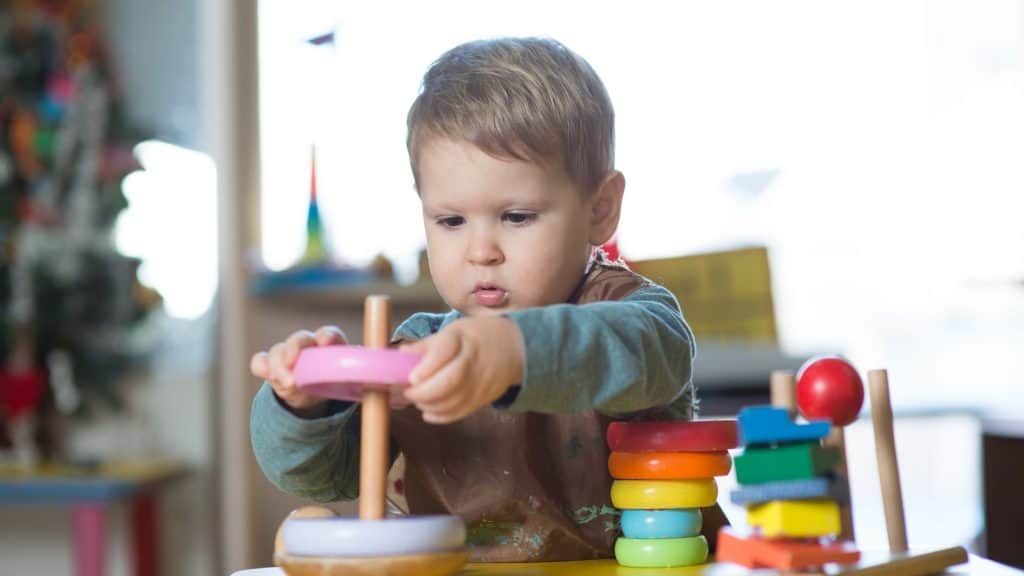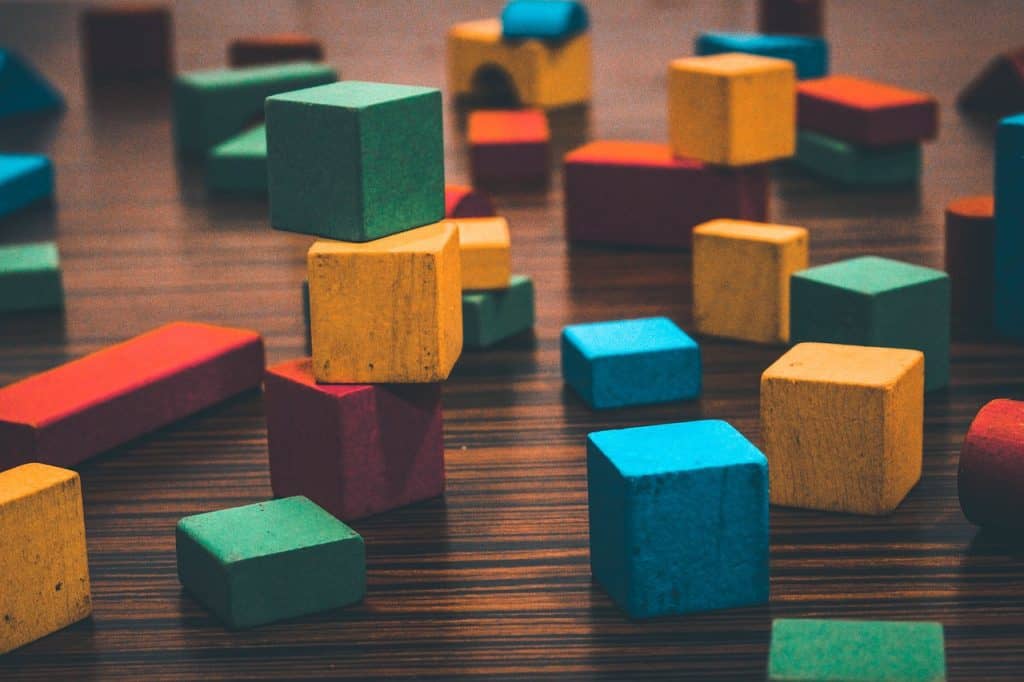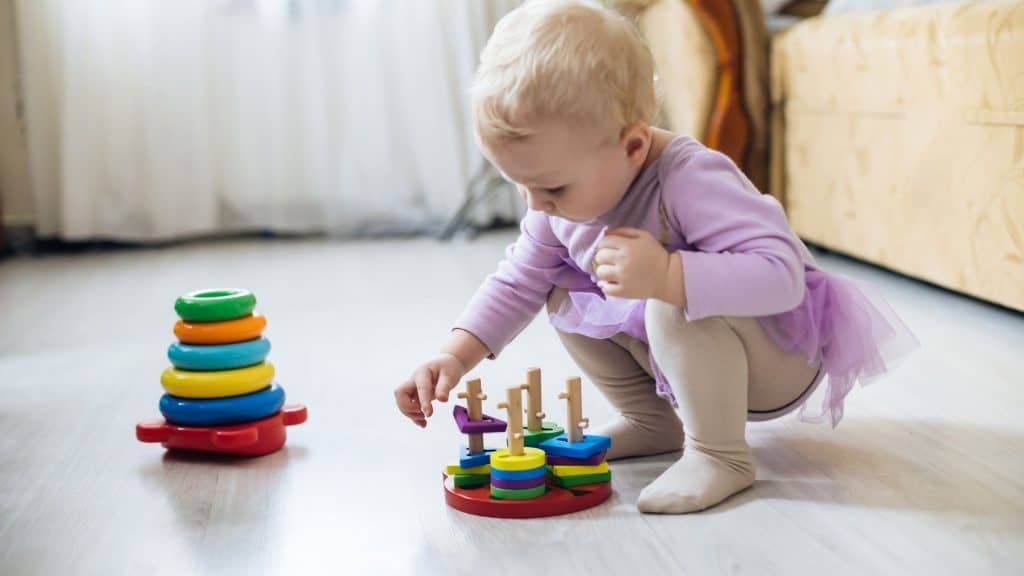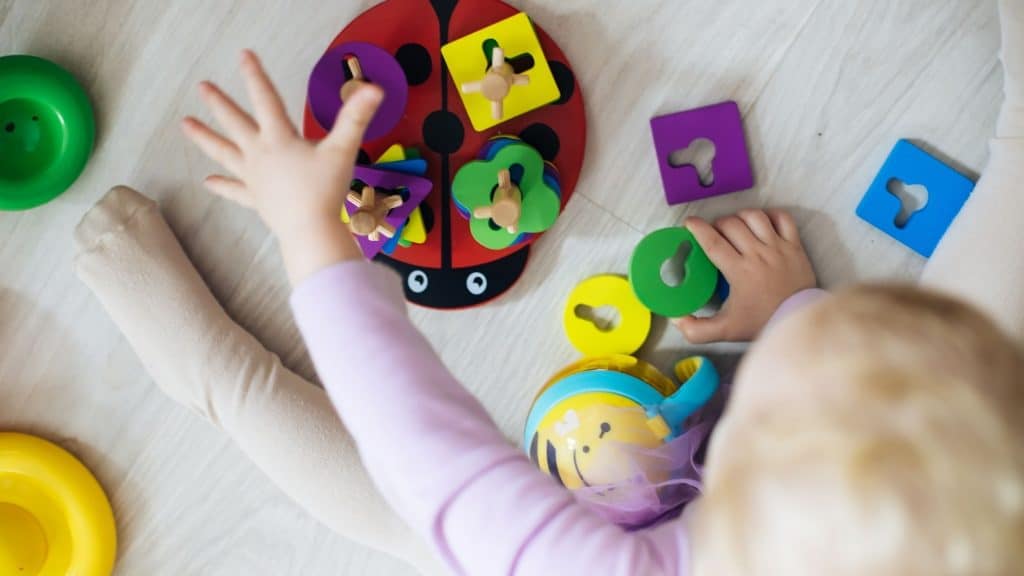One important aspect of Montessori-style play and learning is to limit the number of options a child has to choose from when selecting an activity. Since Montessori open-ended toys are designed to foster creativity, independence, and open-ended play, the limited number of choices benefits children because they are not overwhelmed or overstimulated.
As parents you may wonder how to prevent boredom or ensure that your child has the opportunity to explore all of the excellent open-ended toys you have carefully chosen and collected for them.
The answer is in learning how to rotate Montessori toys.

Toy rotation basically means that you periodically switch out the toys your child has to choose from during playtime.
This then begs the next question; how often should you rotate toys?
On average, plan to rotate toys at least once a month, although for some families the rotation may need to happen more or less frequently. One child may need to see a change in Montessori toy options every five days, while another child may not need a toy rotation until ten to fourteen days have passed.
It is important to watch your child and how their interest in the available toys changes with time. If you start noticing some frustration and lack of interest, it may be time to rotate the toys.
What is toy rotation in Montessori-style play?
Montessori toy rotation is a method of both organizing and presenting options for open-ended toys that will not overwhelm your child with too many choices while avoiding a confusing, overstimulating toy shelf packed with options.
Parents or caregivers decide on a set number of toys to make available in the playroom, while keeping the rest out of sight until it is time to change things up and rotate the toys. The result is a tidier playroom and better opportunities for your child to focus and master the individual skills for which each toy is designed.
Implementing an effective toy rotation depends on a strong understanding of why to rotate toys, when it should be done, and how to do so.
In the following sections, we will take a closer look at what it takes to successfully implement a Montessori toy rotation.

Why should you rotate toys?
There are a number of good reasons why it can be helpful to implement a Montessori toy rotation.
- Babies and toddlers experience their world through their senses, and a tidy space with limited options prevents overstimulation and frustration.
- Children are more likely to experience meaningful engagement and skill development when presented with limited options during open-ended play, in part because they will choose toys that truly hold their interest.
- The reintroduction of a toy after a child begins to lose interest in the current set of toys sparks renewed curiosity and engagement.
- Maintaining a tidy, organized playroom is easier for both parents and children when there are fewer toys to manage, and children will be able to independently clean up with greater success.
- Neatness in the playroom makes it easier for a child to choose which activity or toy he wants to play with.
- Parents will be more mindful about which toys are beneficial to keep in the home and which toys are unnecessary or unwanted; those which are not routinely used can be purged from the house through donation, yard sales, or discarded if broken or missing parts.

How to effectively rotate toys
The implementation of a Montessori toy rotation can be broken down into a few simple steps. These steps do take some time to work through, but the effort you put into this process will result in more engaging, meaningful play for your child in the end.
Observe
Begin by quietly observing your child at independent play and make note of the toys he tends to favor, the obvious developmental skills he is working on, items that he may be ignoring or discarding after only a few minutes of play.
Also look carefully at the play space itself to see how you are currently organizing your child’s toys and their place in his environment.
This process may take a few days, and you should take definitive notes with pen and paper. Keep a notebook with you and also observe how your child interacts with his environment in other parts of the house, like the nursery, kitchen, or outside play areas.
You want to determine his interests and needs before you begin to purge, sort, store, and organize.
Assess
At a time when your child is not around, such as during an extended sleep time or while he is at school, lay all of your child’s toys out in a large open space so you can see everything.
Use the notes you took to sort out toys that are favorites or developmentally appropriate from those that are often shown disinterest by your child.
Any items that your child does not play with, or which are age or developmentally inappropriate, should be set aside for donation or to store long-term for younger siblings (if you have the space).
Also look for toys that are broken, worn, or missing pieces to be discarded.
Prepare
In this step, focus on getting your child’s play environment ready, and consider how his needs will change over time while he grows.
If you do not already have a designated play space, now is a good time to choose an area of your house that you can dedicate to open-ended play, such as an unused spare bedroom, a bonus room, or even a corner of the main living area of the house that can be repurposed.
Low, easily accessible, open shelving options are best for holding toys, even if you plan on organizing some items in shallow baskets or trays. You want to make sure your child can select toys and put them away independently, as well as make everything neat and visible.
Finally, consider creating areas in the playroom that can be used for different activities, like a child-sized table and chair for arts and crafts or a comfy reading nook with pillows or a child-sized lounge chair.
If children of different ages will be sharing the space, it is also helpful to create spaces for each of their belongings.
Select
Use your notes from your observations to select the toys you want to put into a toy rotation.
Keep the options minimal, no more than 8 to 10 toys at a time.
Place larger items directly on the shelf, while smaller toys or those with multiple pieces can be placed into shallow baskets or trays.
Allow for space between toys on the shelf, which helps with both neatness as well as visibility for your child. Store toys for future rotations in baskets on a high shelf or in bins in a closet.
Guide
Now it’s time to introduce your child to the changes you have made in the playroom.
Give a brief tour of their new space and discuss your expectations for cleaning up with your child. Even young toddlers can pick up after themselves with a little modeling and timely reminder.
Infants, of course, would not be expected to independently clean up their toys, but you can start to model this process with them. Guide your child through the process of organizing and cleaning up for the first few days when playtime is through.
Repeat
In the days before each toy rotation, take some time to observe your child at play and how he is interacting with his environment.
Make any adjustments as necessary, from the selection of toys in the rotation to how the play area is organized.
The goal is to make the space functional for your child’s independent, open-ended play, while also allowing for flexibility as your child grows in age and development.

Montessori Toy Rotation FAQ
How many toys should you be rotating in and out?
The number of toys you make available to your child will depend, in part, on your child’s age. As a general guideline, 8 to 10 toys is a good number to keep out in the playroom during a rotation.
Some children may be all right with up to twelve toys; it is important to observe your child during the initial implementation of your toy rotation to determine the best number of toys to keep out at a time.
Additionally, not every toy needs to be changed with every rotation. Favorites that your child plays with regularly can be left out for weeks or months, perhaps even longer if interest remains high.
Books, too, are part of the rotation, but typically only one or two books need to be changed during a given rotation.
How do you know when it’s time to rotate toys?
Observe your child during playtime and take note of which toys, if any, seem to be unappealing to him or which he has outgrown in terms of developmental skill mastery.
Also, look to see if your child seems bored with any of his current toys. These can be replaced by toys from storage to meet your child’s current developmental needs, age, and interests.
Babies and young toddlers, in particular, experience many rapid developmental changes in a very short amount of time. You will know when it is time to rotate toys when you notice the appearance of motor skills, like the pincer grip, or changes in attention span and coordination.
How should you store Montessori toys?
There are many storage options available for Montessori style learning. The storage option you choose will depend on the space you have to keep stored Montessori toys out of your child’s sight.
Plastic bins that can be easily stacked may work well for one family, while other families may prefer storage drawers or cabinets with baskets. Whatever you decide to put the unused toys in, sort them by theme, type, or age range and clearly label the container accordingly. Storage containers should be covered to keep out dust, dirt, or pests that could ruin toys.
How do you organize Montessori toys?
Montessori toys should be organized in such a way that they are easily visible and accessible to your child. Low shelves or cubbies place toys and activities at an ideal height for toddlers and young preschoolers.
Larger open ended toys can simply be placed on a shelf, while smaller items or toys that may have separate pieces might be better kept in a shallow basket or tray. It is important to maintain visibility so your child is not frustrated in selecting the toy he wants.
Keep only one or two toys per section in order to not clutter the space and the choices your child has.
Putting space between toys on the shelf also aids in visibility and keeps the toy shelf looking neat.
Vikki is the creator of Totsgo and the mother of two children. She is a passionate mother who enjoys assisting other parents.
